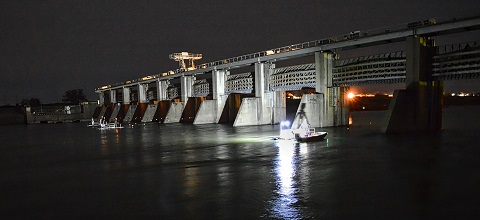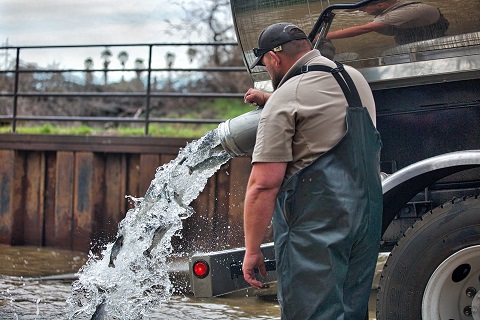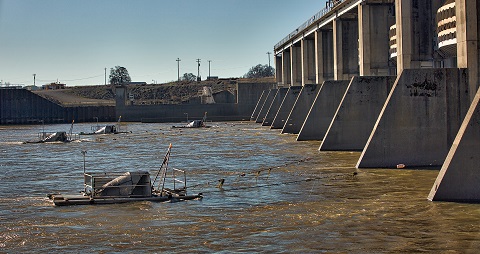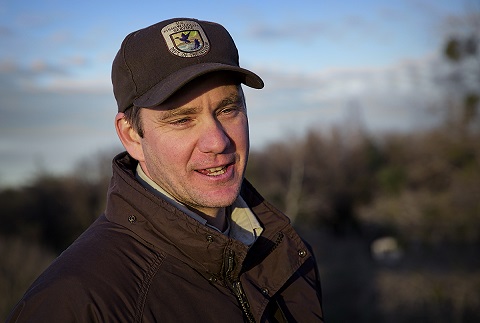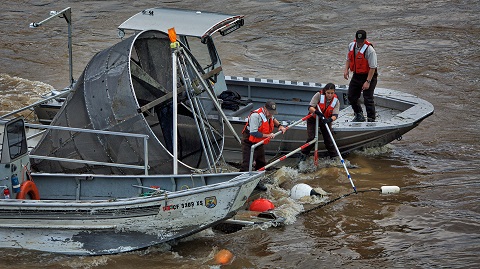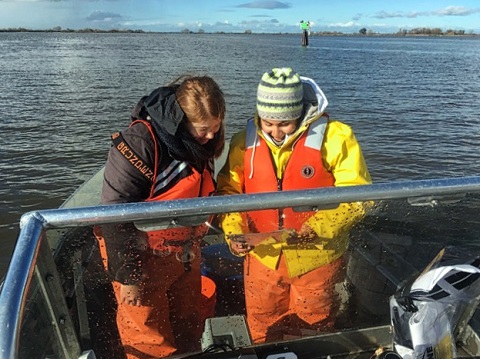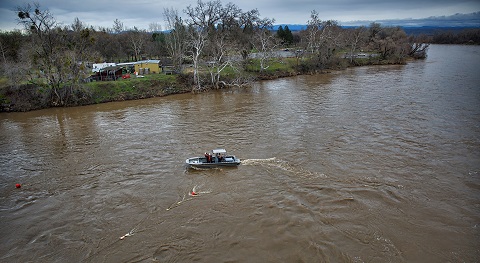Sacramento River Fish Report for 1-21-2017
Rain or shine, Service Biologists work through tough weather conditions
Sacramento River - CA
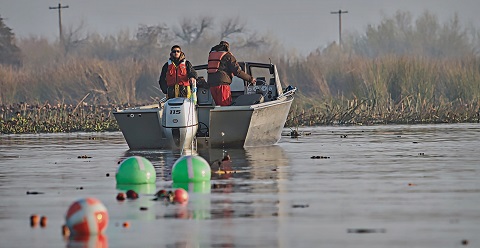
by Steve Martarano
1-21-2017
The rains came, and the U.S. Fish and Wildlife Service got to work.
Whether it was to release more than a half-million steelhead, making sure rotary screw collection traps on the upper Sacramento River were preserved, or monitoring for Delta smelt, a little inclement weather wasn’t stopping the Service from crucial daily activities.
The very welcome wet opening to 2017 didn’t slow down the Coleman National Fish Hatchery’s scheduled week-long efforts to release 600,000 year-old steelhead into a Sacramento River location near Red Bluff.
Steelhead raised at Coleman help provide fish to the Sacramento-San Joaquin Bay-Delta sport fishery as well as to provide adults who return up river to the hatchery. The yearly releases are crucial to keeping the steelhead fishery strong.
“No, the weather didn’t stop us; we were delivering in a pretty significant rainstorm,” said Brett Galyean, project leader at Coleman, who directed efforts to load, truck and then release the fish at the Bend Bridge Boat Ramp in Red Bluff beginning on a very rainy Jan. 3. After a couple of drier days, the crew dealt with freezing temperatures and ice at the hatchery by using salt to help with truck traction on the project’s final day.
Galyean said stormy weather, high river flows and turbidity are excellent release conditions that help expedite the steelhead migration to the Pacific Ocean.
With the steelhead deliveries complete and facing an even wetter following week, Galyean’s crew began preparing the Coleman hatchery raceways for the next big yearly delivery – the release of 12 million fall-run Chinook salmon beginning in the early spring.
“We are planning to be in the rain if we have to, cleaning and prepping the raceways and putting in new screens,” Galyean said. “The process continues regardless of weather conditions and the hatchery staff will get it done.”
Just south of Coleman is the Red Bluff Diversion Dam, where the Red Bluff Fish and Wildlife Office collects fish passage data daily from four space-capsule looking rotary screw traps which provide key information on how well the state’s crucial salmon fishery is doing. Regardless of the wind, rain or temperatures, staff with the Mainstem Juvenile Monitoring Program work days and nights clearing debris from the traps.
With flows on the Sacramento River at dangerously high levels for the traps, program staff methodically began removing the traps under rainy conditions early in the week of Jan. 2. When the river flows lowered with calmer weather, crews redeployed the traps and began sampling again after being out of commission for two days. Later in the week, before an even larger storm rolled in, the dismantling process began again.
“These can be cold, soggy and long shifts for our crew,” said Josh Gruber, the supervisory fish biologist for the Mainstem Juvenile Monitoring Program, referring to the days the traps are sampling.
“My crew will often interact with the public and will hear comments such as ‘you guys have the best job in the world.’ We all agree with that, but then again, they don’t see us at 2 a.m. in the driving rain, either,” he laughed.
Earlier this season, the Mainstem crew collected 96 samples within a two-week period in all weather conditions, nearly double their normal workload, to ensure key data was collected to generate an estimate of juvenile fish passing through during their critical migration period.
The rotary screw traps at the Red Bluff Diversion Dam are the collection points for the Juvenile Monitoring Program, in operation since 1994, and are used daily to sample for juvenile salmon, steelhead and sturgeon.
The information gathered is used, among other things, by the National Oceanic and Atmospheric Administration and other agencies as a basis to estimate the number of endangered winter run fish entering the Delta system.
"Missing even one day of the survey can affect the data, but accurate estimates can still be made using scientifically valid statistical methods." he said.
“The data we provide is so important that we hate being down for any period of time,” he said. “But the safety of our crews and keeping equipment in operable condition is first and foremost.”
Meanwhile, the boat crews out of the Lodi Fish and Wildlife Office also continued their work in the rain. For the fourth year in a row, the Lodi staff conducted additional surveys for imperiled Delta smelt, launching up to five tows a day at each of several locations on the San Joaquin and Lower Sacramento Rivers and Honker Bay/Suisun Bay.
The monitoring program, expanded this year, has been ongoing since Dec. 19 and provides the Service and state and federal water managers with valuable near real-time information about the number and location of Delta smelt, as well as other data for an ongoing Delta smelt markings study.
The crews have been on a regular four-days-per-week schedule and have been out in the rain several times during the early 2017 storms, said Matthew Dekar, the office’s deputy project leader, noting that increased precipitation could trigger the movement of Delta smelt.
“Documenting that is supercritical, and we’ve been out through several wet weather days,” Dekar said, adding that the surveys are meant to help inform water project managers should the imperiled fish moved closer to irrigation water diversions in the southern Delta, where they become entrained and cannot escape.
“Rain events are important for the behavior of the species we’re monitoring; so it’s even more important to be out,” Dekar said, adding that dangerous and ultra-stormy conditions will sideline his crew.
Either way, let that needed rainfall continue. Most likely, Service biological staff will still be trucking salmon and counting fish to understand and ensure the health of local fisheries.
Steve Martarano is the public affairs specialist for the San Francisco Bay-Delta Fish and Wildlife Office located in Sacramento, Calif.
Photos
Next Report >
Next Report >
More Reports
Colorado River - Willow Beach Fishing Report
Colorado River - Willow BeachWillow Beach, Ariz. – After a three-year hiatus, catchable-sized rainbow trout from Willow Beach National Fish Hatchery (NFH) return to Colorado River waters downstream of Las Vegas, Nevada. The hatchery will release 2,500 rainbow trout into the cold waters below Davis Dam on January 12, 2017. The trout measure up to 12 inches long. Davis Camp and Bullhead City Park will be stocked once more in January; three times in February; four times in March and once in April, for...... Read More
Willow Beach Hatchery Update
Colorado River - Willow Beach
12-20-2016
A new water intake for Willow Beach National Fish Hatchery (NFH) in Willow Beach, Arizona, has been built and tested...... Read More

Website Hosting and Design provided by TECK.net
